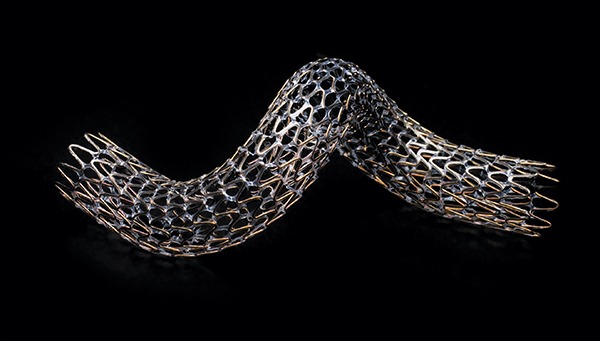
Gore has announced US Food and Drug Administration (FDA) approval of the Gore Tigris vascular stent, a dual-component stent with a unique fluoropolymer/nitinol design. The Gore Tigris device, which gained CE mark approval in 2011, is a third-generation, self-expanding stent. The device was designed explicitly to improve anatomical conformability with the natural movement of the knee when treating peripheral arterial disease.
The newly-approved Gore Tigris vascular stent uses a dual component structure, made from a single-wire nitinol stent with flexible and biocompatible fluoropolymer interconnections. The stent has been designed to weather biomechanical forces (extension, compression, flexion and torsion) without fractures, even in the most complex anatomies, namely in the superficial femoral artery (SFA) and proximal popliteal artery (PPA). In the US clinical study that supported FDA approval of the Gore Tigris vascular stent, the Tigris stent was found to have zero fractures, while the control arm devices experienced a 27% fracture rate.
“The Tigris vascular stent has an innovative design that is very different from any of the other nitinol stents that we currently use. The extreme flexibility of this stent makes it well suited for the superficial femoral artery and proximal popliteal artery, and the delivery system is highly accurate. The precision offered by this flexible, dual component device allows for easy insertion and predictable clinical outcomes, even in challenging anatomy,” said John R Laird, an interventional cardiologist in Davis, USA.
The new device builds on the company’s long history and experience with stenting, which spans more than two decades. The Gore Tigris vascular stent also features Gore’s CBAS Heparin Surface, the proven, lasting heparin bonding technology designed to resist thrombus formation, a problem common in both bare metal and drug-eluting stents. Endpoint covalent bonding keeps heparin anchored to the stent surface, while the bioactive site remains free to interact with the blood to help prevent clotting.
“At Gore, we pride ourselves in continuous evaluation of how our technologies can benefit patients. To design an uncovered stent that navigates and conforms to the complex anatomy of the artery, we leveraged our long history with endovascular devices to develop the Gore Tigris vascular stent. The addition of this device to our peripheral interventional portfolio enables physicians to treat more diverse cases with Gore’s best in class products,” said Ray Swinney, Business Unit Leader for the Gore Peripheral Interventional Business Unit.
The evolution of peripheral stenting over the past decade has allowed for broader adoption of endovascular therapy for treating peripheral arterial disease. When physicians began placing stents in the SFA they were limited by first generation stent designs that had longitudinal metal connections which led to arterial stiffening, high fracture rates and poorer clinical outcomes. Improvements in second generation devices introduced helical interconnections to improve flexibility; however, their success in high flexion vessels, like the distal SFA and PPA, was still limited.* The introduction of third generation stents, including the Gore Tigris vascular stent, allow for better adherence in some of the more intricate vessels in the body.
*Thaveau F, Méteyer V, LeJay A, Chakfé N. Latest generation of conforming dual component stent. In: Greenhalgh RM, ed. Charing Cross 2016-Vascular & Endovascular Challenges Update. 2016 ed. Fulham, London, United Kingdom: BIBA Publishing; 2016:423-428.













